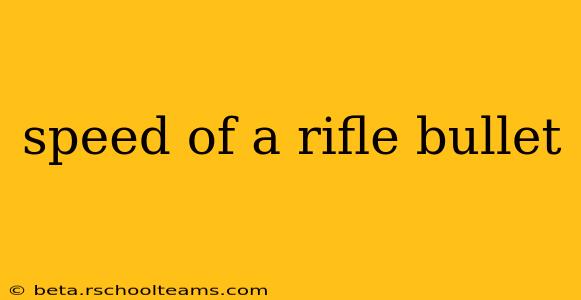The speed of a rifle bullet, often expressed as muzzle velocity, is a crucial factor influencing its accuracy, range, and effectiveness. Understanding this velocity, the factors affecting it, and how it's measured is vital for both enthusiasts and professionals alike. This article will explore these aspects in detail.
What Determines a Rifle Bullet's Speed?
Several key factors contribute to the final velocity of a bullet leaving the muzzle of a rifle:
1. Cartridge and Powder Charge: The Primary Drivers
The type of cartridge used is paramount. Different cartridges contain varying amounts of propellant (gunpowder). A larger powder charge generates significantly more pressure, propelling the bullet to a higher velocity. The composition of the gunpowder also plays a role, with some formulations burning faster or slower than others, influencing the pressure curve and ultimately the bullet's speed.
2. Barrel Length: The Acceleration Zone
A longer barrel allows for more complete propellant combustion and a longer period of acceleration for the bullet. This translates directly into higher muzzle velocity. Conversely, shorter barrels result in lower velocities due to less time for the bullet to accelerate.
3. Bullet Weight: The Mass Factor
Heavier bullets require more force to achieve the same velocity as lighter bullets. While a larger powder charge can compensate for this, there are practical limits to how much propellant can be safely used in a given cartridge. This is a key trade-off; heavier bullets often have better ballistic properties at longer ranges, but at the cost of velocity.
4. Barrel Rifling: Guiding the Projectile
The rifling in the barrel, the spiral grooves that impart spin to the bullet, also has a slight effect on velocity. The friction generated by the rifling slightly reduces the bullet's speed, although this effect is typically minor compared to the others mentioned above.
5. Environmental Conditions: External Influences
Environmental factors such as air temperature, humidity, and air pressure can subtly affect muzzle velocity. Higher temperatures generally lead to slightly higher velocities, while lower temperatures can decrease them. The effect is generally small but measurable, particularly at extreme temperatures.
Measuring Muzzle Velocity: Techniques and Tools
Accurate measurement of muzzle velocity is essential for ballistic calculations, load development, and understanding firearm performance. This is commonly achieved through the use of:
1. Chronographs: The Standard Method
Chronographs are electronic devices that measure the time it takes for a bullet to travel between two sensors placed a known distance apart. By knowing the distance and the time, the velocity can be calculated with precision. This is the most common and accurate method used by both hobbyists and professionals.
2. Doppler Radar: A Contactless Alternative
Doppler radar systems can measure the velocity of a bullet without physically interrupting its trajectory. This is particularly useful for testing high-powered rifles where placing sensors close to the muzzle could be dangerous. However, these systems are typically more expensive than chronographs.
Conclusion: Understanding the Speed is Key
The speed of a rifle bullet is a complex interplay of various factors, all contributing to its final velocity. Understanding these factors and the methods used to measure velocity is crucial for anyone interested in firearms, ballistics, or precision shooting. Whether you are a seasoned shooter or just beginning to explore the world of firearms, knowledge of these principles will enhance your appreciation for the science and technology behind projectile motion.
